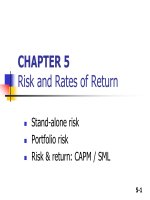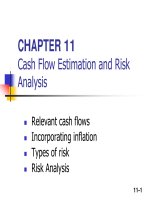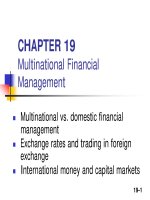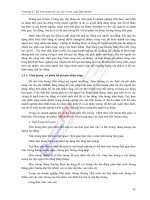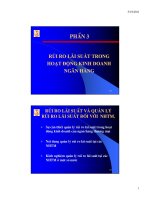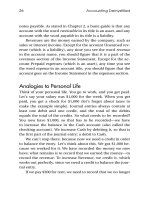International Financial Management phần 3 pdf
Bạn đang xem bản rút gọn của tài liệu. Xem và tải ngay bản đầy đủ của tài liệu tại đây (727.94 KB, 10 trang )
Purchase Insurance, 492
Use Project Finance, 492
Summary, 492
Point Counter-Point: Does Country Risk Matter for U.S. Projects? 493
Self-Test, 493
Questions and Applications, 494
Advanced Questions, 495
Discussion in the Boardroom, 498
Running Your Own MNC, 498
Blades, Inc. Case: Country Risk Assessment, 498
Small Business Dilemma: Country Risk Analysis at the Sports Exports Company, 500
Internet/Excel Exercise, 500
References, 500
17: MULTINATIONAL COST OF CAPITAL AND CAPITAL STRUCTURE
This chapter is made available to you at www.cengage.com/finance/
madura.
18: LONG-TERM FINANCING
This chapter is made available to you at www.cengage.com/finance/
madura.
Part 4 Integrative Problem: Long-Term Asset and Liability Management is made available
to you at www.cengage.com/finance/madura.
PART 5: Short-Term Asset and Liability Management 557
19: FINANCING INTERNATIONAL TRADE
This chapter is made available to you at www.cengage.com/finance/
madura.
20: SHORT-TERM FINANCING
This chapter is made available to you at www.cengage.com/finance/
madura.
21: INTERNATIONAL CASH MANAGEMENT
This chapter is made available to you at www.cengage.com/finance/
madura.
Appendix 21: Investing in a Portfolio of Currencies is made available to you at www.
cengage.com/finance/madura.
Part 5 Integrative Problem: Short-Term Asset and Liability Management is made available
to you at www.cengage.com/finance/madura.
Final Self-Exam, 625
Appendix A: Answers to Self-Test Questions, 635
Appendix B: Supplemental Cases, 647
Cases for web-only chapters are made available to you at www.cengage.com/finance/
madura.
Appendix C: Using Excel to Conduct Analysis, 669
Appendix D: International Investing Project, 677
Contents xix
Copyright 2010 Cengage Learning. All Rights Reserved. May not be copied, scanned, or duplicated, in whole or in part. Due to electronic rights, some third party content may be suppressed from the eBook and/or eChapter(s).
Editorial review has deemed that any suppressed content does not materially affect the overall learning experience. Cengage Learning reserves the right to remove additional content at any time if subsequent rights restrictions require it.
Licensed to:
iChapters User
Appendix E: Discussion in the Boardroom, 680
Exercises for web-only chapters are made available to you at www.cengage.com/
finance/madura.
Glossary, 689
Direct Exchange Rates over Time, 699
Index, 703
International Credit Crisis Timeline, 710
xx Contents
Copyright 2010 Cengage Learning. All Rights Reserved. May not be copied, scanned, or duplicated, in whole or in part. Due to electronic rights, some third party content may be suppressed from the eBook and/or eChapter(s).
Editorial review has deemed that any suppressed content does not materially affect the overall learning experience. Cengage Learning reserves the right to remove additional content at any time if subsequent rights restrictions require it.
Licensed to:
iChapters User
From the Publisher
International Financial Management: Abridged 10th Edition is our offering of a more
course-specific, lower cost alternative to International Financial Management: 10th Edition
for students and instructors. Based on market research with faculty using International
Financial Management: 10th Edition, we found that many instructors covered less than the
twenty-one chapters contained in that textbook. That same research showed that the chap-
ters contained in this abridged version are those that most professors cover in a one-term
course. For those instructors that subscribe to this coverage trend, this abridged version is a
more efficient and economical alternative to use with students taking their course.
TheapproachwehavetakenwithInternational Financial Management: Abridged 10th
Edition is to remove whole specific chapters in their entirety, all end-of-chapter appendices,
and all end-of-part integrative problems. Pagination of this abridged version is consistent
with International Financial Management: 10th Edition so that all student-oriented supple-
ments, as well as instructor supplements, will work with either version of the book. A class-
room of students using either version of the book will be able to follow along on the same
page without need for “translating” page numbers. For those instructors who feel that one or
more of the eliminated chapters, chapter appendices, or integrated problems are needed in
their course, both instructors and students can freely access PDFs of these chapters or
appendices at the textbook’swebsiteatwww.cengage.com/finance/madura.
xxi
Copyright 2010 Cengage Learning. All Rights Reserved. May not be copied, scanned, or duplicated, in whole or in part. Due to electronic rights, some third party content may be suppressed from the eBook and/or eChapter(s).
Editorial review has deemed that any suppressed content does not materially affect the overall learning experience. Cengage Learning reserves the right to remove additional content at any time if subsequent rights restrictions require it.
Licensed to:
iChapters User
Copyright 2010 Cengage Learning. All Rights Reserved. May not be copied, scanned, or duplicated, in whole or in part. Due to electronic rights, some third party content may be suppressed from the eBook and/or eChapter(s).
Editorial review has deemed that any suppressed content does not materially affect the overall learning experience. Cengage Learning reserves the right to remove additional content at any time if subsequent rights restrictions require it.
Licensed to:
iChapters User
Preface
Businesses evolve into multinational corporations (MNCs) so that they can capitalize on
international opportunities. Their financial managers must be able to assess the interna-
tional environment, recognize opportunities, implement strategies, assess exposure to
risk, and manage the risk. The MNCs that are most capable of responding to changes
in the international financial environment will be rewarded. The same can be said for
the students today who may become the future managers of MNCs.
INTEND ED MARKET
International Financial Management, Abridged Tenth Edition, presumes an understanding
of basic corporate finance. It is suitable for both undergraduate and master’s level courses in
international financial management. For master’s courses, the more challenging questions,
problems, and cases in each chapter are recommended, along with special projects.
ORGANIZATION OF THE TEXT
International Financial Management, Abridged Tenth Edition, is organized first to provide
a background on the international environment and then to focus on the managerial aspects
from a corporate perspective. Managers of MNCs will need to understand the environment
before they can manage within it.
The first two parts of the text provide the macroeconomic framework for the text. Part 1
(Chapters 1 through 5) introduces the major markets that facilitate international business.
Part 2 (Chapters 6 through 8) describes relationships between exchange rates and economic
variables and explains the forces that influence these relationships.
The remainder of the text provides a microeconomic framework, with a focus on the
managerial aspects of international financial management. Part 3 (Chapters 9 through 12)
explains the measurement and management of exchange rate risk. Part 4 (Chapters 13
through 16) describes the management of long-term assets and liabilities, including motives
for direct foreign investment, multinational capital budgeting, and country risk analysis.
Each chapter is self-contained so that professors can use classroom time to focus on
the more comprehensive topics and rely on the text to cover the other concepts. The
management of long-term assets (chapters on direct foreign investment, multinational
capital budgeting, multinational restructuring, and country risk analysis) is covered before
the management of long-term liabilities (chapters on capital structure and long-term
financing), because the financing decisions are dependent on the investments. Neverthe-
less, concepts are explained with an emphasis on how management of long-term assets
and long-term liabilities is integrated. For example, the multinational capital budgeting
analysis demonstrates how the feasibility of a foreign project may be dependent on the
financing mix. Some professors may prefer to teach the chapters on managing long-term
liabilities before the chapters on managing long-term assets.
The strategic aspects such as motives for direct foreign investment are covered before
the operational aspects such as short-term financing or investment. For professors who
prefer to cover the MNC’s management of short-term assets and liabilities before the
management of long-term assets and liabilities, the parts can be rearranged because they
are self-contained.
xxiii
Copyright 2010 Cengage Learning. All Rights Reserved. May not be copied, scanned, or duplicated, in whole or in part. Due to electronic rights, some third party content may be suppressed from the eBook and/or eChapter(s).
Editorial review has deemed that any suppressed content does not materially affect the overall learning experience. Cengage Learning reserves the right to remove additional content at any time if subsequent rights restrictions require it.
Licensed to:
iChapters User
Professors may limit their coverage of chapters in some sections where they believe
the text concepts are covered b y other courses or do not need additional attention
beyond what is in the text. For example, they m ay give less attention to the chapters in
Part 2 (Chapters 6 through 8) if their students take a course in international economics.
If professors focus on the main principles, they may limit their coverage of Chapters 5,
15, and 16.
APPROACH OF THE TEXT
International Financial Management, Abridged Tenth Edition, focuses on management
decisions that maximize the value of the firm. It is designed in recognition of the fact
that each instructor has a unique way of reinforcing key concepts. Thus, the text offers a
variety of methods of reinforcing these concepts so that instructors can select the methods
and features that fit their teaching styles.
• Part-Opening Diagram. A diagram is provided at the beginning of each part to
illustrate how the key concepts covered in that part are related. This offers some
information about the organization of chapters in that part.
• Objectives. A bulleted list at the beginning of each chapter identifies the key concepts
in that chapter.
• Examples. The key concepts are thoroughly described in the chapter and supported
by examples.
• Governance. This feature is integrated throughout the text in recognition of its
increasing popularity and use in explaining concepts in international financial
management.
• International Credit Crisis. Coverage of the international credit crisis is provided in
each chapter where applicable.
• Term Paper on the International Credit Crisis. Suggested assignments for a term
paper on the international credit crisis are provided at the end of Chapter 1.
• Web Links. Websites that offer useful related information regarding key concepts are
provided in each chapter and online at www.cengage.com/finance/madura.
• Summary. A bulleted list at the end of each chapter summarizes the key concepts.
This list corresponds to the list of objectives at the beginning of the chapter.
• Point/Counter-Point. A controversial issue is introduced, along with opposing
arguments, and students are asked to determine which argument is correct and
explain why.
• Self-Test Questions. A “Self-Test” at the end of each chapter challenges students on
the key concepts. The answers to these questions are provided in Appendix A.
• Questions and Applications. Many of the q uestions and other applications at the
end of each chapter test the student ’ s knowledge of the key concepts in the
chapter.
• “Blades, Inc.” Continuing Case. At the end of each chapte r, the continuing case
allows students to use the key c oncepts to solve problems experienced by a firm
called Blades, Inc. (a producer of roller blades). By working on cases related to the
same MNC over a school term, students recognize how an MNC’sdecisionsare
integrated.
xxiv Preface
Copyright 2010 Cengage Learning. All Rights Reserved. May not be copied, scanned, or duplicated, in whole or in part. Due to electronic rights, some third party content may be suppressed from the eBook and/or eChapter(s).
Editorial review has deemed that any suppressed content does not materially affect the overall learning experience. Cengage Learning reserves the right to remove additional content at any time if subsequent rights restrictions require it.
Licensed to:
iChapters User
• Small Business Dilemma. The Small Business Dilemma at the end of each chapter
places students in a position where they must use concepts introduced in the chap-
ter to make decisions about a small MNC called Sports Exports Company.
• Internet/Excel Exercises. At the end of each chapter, there are exe rcises that expose
the students to applicable information available at various websites, enable the ap-
plication of Excel to related topics, or a combination of these. For example, students
learn how to obtain exchange rate information online and apply Excel to measure
the value at risk.
• Midterm and Final Examinations. A midterm self-exam is provided at the end of
Chapter 8, which focuses on international macro and market conditions (Chapters 1
through 8). A final self-exam is provided at the end of Chapter 16, which focuses on
the managerial chapters (Chapters 9 through 16). Students can compare their an-
swers to those in the answer key provided.
• Supplemental Cases. Supplemental cases allow students to apply chapter concepts to
a specific situation of an MNC. All supplemental cases are located in Appendix B at
the end of the text. Supplemental case content for online-only Chapters 17–21 is
available at www.cengage.com/finance/madura.
• Running Your Own MNC. This project (provided at www.cengage.com/finance/
madura) allows each student to create a small international business and apply key
concepts from each chapter to run the business throughout the school term.
• International Investing Project. This project (in Appendix D and also provided at
www.cengage.com/finance/madura) allows students to simulate investing in stocks of
MNCs and foreign companies and requires them to assess how the values of these
stocks change during the school term in response to international economic conditions.
• Discussion in the Boardroom. This project (in Appendix E and also provided at
www.cengage.com/finance/madura) allows students to play the role of managers or
board members of a small MNC that they created and make decisions about that firm.
• References. References to related readings are provided for every chapter.
The variety of end-of-chapter and end-of-part exercises and cases offer many opportu-
nities for students to engage in teamwork, decision making, and communication.
SUPPLEMENTAL RESOURCES
The text website at www.cengage.com/finance/madura provides additional instructor
resources:
• Instructor’s Manual. The Instructor’s Manual contains the chapter theme, topics to
stimulate class discussion, and answers to end-of-chapter Questions, Case Problems,
Continuing Cases (Blades, Inc.), Small Business Dilemmas, Integrative Problems,
and Supplemental Cases. The Instructor’s Manual is available on the text website
and also the Instructor’s Resource CD (IRCD).
• PowerPoint Presentation Slides. Revised by Nivine Richie of the University of North
Carolina (Wilmington) for this edition, the PowerPoint slides are intended to en-
hance lectures and provide a guide for student note-taking. Basic Lecture Slides are
included on both the text website and IRCD, while supplemental Exhibit Slides can
be downloaded from the text website.
Preface xxv
Copyright 2010 Cengage Learning. All Rights Reserved. May not be copied, scanned, or duplicated, in whole or in part. Due to electronic rights, some third party content may be suppressed from the eBook and/or eChapter(s).
Editorial review has deemed that any suppressed content does not materially affect the overall learning experience. Cengage Learning reserves the right to remove additional content at any time if subsequent rights restrictions require it.
Licensed to:
iChapters User
• Test Bank. An expanded Test Bank contains a large set of questions in multiple
choice or true/false format, including content questions as well as problems. The
Test Bank is available on the text website and the IRCD.
• ExamView
™
Test Bank. The ExamView computerized testing program contains all of
the questions in the Test Bank. It is easy-to-use test creation software that is compatible
with Microsoft
®
Windows. Instructors can add or edit questions, instructions, and an-
swers and select questions by previewing them on the screen. Instructors can also create
and administer quizzes online, whether over the Internet, a local area network (LAN), or
a wide a rea n etwork (WA N). ExamView
™
is available on the IRCD only.
ACKNOWLEDGMENTS
Several people have contributed to this textbook. First, the motivation to write the text-
book was primarily due to encouragement by Professors Robert L. Conn (Miami Univer-
sity of Ohio), E. Joe Nosari and William Schrode (Florida State University), Anthony E.
Scaperlanda (Northern Illinois University), and Richard A. Zuber (University of North
Carolina at Charlotte).
Many of the revisions and expanded sections contained in this edition are due to
comments and suggestions from students who used previous editions. In addition,
many professors reviewed various editions of the text and had a major influence on its
content and organization. All are acknowledged in alphabetical order:
Raj Aggarwal, John Carroll University
Alan Alford, Northeastern University
H. David Arnold, Auburn University
Robert Aubey, University of Wisconsin
Bruce D. Bagamery, Central Washington
University
James C. Baker, Kent State University
Gurudutt Baliga, University of Delaware
Laurence J. Belcher, Stetson University
Richard Benedetto, Merrimack College
Bharat B. Bhalla, Fairfield University
Rahul Bishnoi, Hofstra University
Rita Biswas, State University of New York–
Albany
Steve Borde, University of Central Florida
Sarah Bryant, George Washington University
Francisco Carrada-Bravo, American Graduate
School of International Management
Andreas C. Christofi, Azusa Pacific
University
Ronnie Clayton, Jacksonville State University
Thomas S. Coe, Quinnipiac University
Alan Cook, Baylor University
W. P. Culbertson, Louisiana State University
Maria deBoyrie, New Mexico State University
Andrea L. DeMaskey, Villanova University
Mike Dosal, SunTrust Bank (Orlando)
Robert Driskill, Ohio State University
Anne M. Drougas, Dominican University
Milton Esbitt, Dominican University
Larry Fauver, University of Miami
Paul Fenton, Bishop’s University
Robert G. Fletcher, California State Univer-
sity–Bakersfield
Stuart Fletcher, Appalachian State University
Jennifer Foo, Stetson University
Robert D. Foster, American Graduate School
of International Management
Hung-Gay Fung, University of Baltimore
Juli-Ann E. Gasper, Texas A&M University
Farhad F. Ghannadian, Mercer University
Wafica Ghoul, Haigazian University
Joseph F. Greco, California State University–
Fullerton
Deborah W. Gregory, Bentley College
Nicholas Gressis, Wright State University
Indra Guertler, Babson College
Ann M. Hackert, Idaho State University
John M. Harris, Jr., Clemson University
Andrea J. Heuson, University of Miami
Ghassem Homaifar, Middle Tennessee State
University
James A. Howard, University of Maryland
Nathaniel Jackendoff, Temple University
Pankaj Jain, University of Memphis
Kurt R. Jesswein, Texas A&M International
Steve A. Johnson, University of Texas–El Paso
Manuel L. Jose, University of Akron
xxvi Preface
Copyright 2010 Cengage Learning. All Rights Reserved. May not be copied, scanned, or duplicated, in whole or in part. Due to electronic rights, some third party content may be suppressed from the eBook and/or eChapter(s).
Editorial review has deemed that any suppressed content does not materially affect the overall learning experience. Cengage Learning reserves the right to remove additional content at any time if subsequent rights restrictions require it.
Licensed to:
iChapters User
Dr. Joan C. Junkus, DePaul University
Rauv Kalra, Morehead State University
Ho-Sang Kang, University of Texas–Dallas
Frederick J. Kelly, Seton Hall University
Robert Kemp, University of Virginia
Coleman S. Kendall, University of Illinois–
Chicago
Dara Khambata, American University
Doseong Kim, University of Akron
Elinda F. Kiss, University of Maryland
Thomas J. Kopp, Siena College
Suresh Krishman, Pennsylvania State Unive rsity
Merouane Lakehal-Ayat, St. John Fisher College
Boyden E. Lee, New Mexico State University
Jeong W. Lee, University of North Dakota
Richard Lindgren, Graceland University
Charmen Loh, Rider University
Carl Luft, DePaul University
K. Christopher Ma, KCM Investment Co.
Davinder K. Malhotra, Philadelphia
University
Richard D. Marcus, University of Wisconsin–
Milwaukee
Anna D. Martin, Fairfield University
Leslie Mathis, University of Memphis
Ike Mathur, Southern Illinois University
Wendell McCulloch, Jr., California State
University–Long Beach
Carl McGowan, University of Michigan–Flint
Fraser McHaffie, Marietta College
Stuart Michelson, Stetson University
Penelope E. Nall, Gardner-Webb University
Vivian Okere, Providence College
Edward Omberg, San Diego State University
Prasad Padmanabhan, San Diego State
University
Ali M. Parhizgari, Florida International
University
Anne Perry, American University
Rose M. Prasad, Central Michigan University
Larry Prather, East Tennessee State University
Abe Qastin, Lakeland College
Frances A. Quinn, Merrimack College
S. Ghon Rhee, University of Rhode Island
William J. Rieber, Butler University
Ashok Robin, Rochester Institute of
Technology
Tom Rosengarth, Westminster College
Kevin Scanlon, Notre Dame University
Michael Scarlatos, CUNY–Brooklyn College
Jacobus T. Severiens, Kent State University
Vivek Sharma, The University of Michigan–
Dearborn
Peter Sharp, California State University–
Sacramento
Dilip K. Shome, Virginia Tech University
Joseph Singer, University of Missouri–Kansas
City
Naim Sipra, University of Colorado–Denver
Jacky So, Southern Illinois University–
Edwardsville
Luc Soenen, California Polytechnic State
University–San Luis Obispo
Ahmad Sohrabian, California State Polytech-
nic University–Pomona
Caroline Spencer, Dowling College
Angelo Tarallo, Ramapo College
Amir Tavakkol, Kansas State University
Stephen G. Timme, Georgia State University
Eric Tsai, Temple University
C. Joe Ueng, University of St. Thomas
Mahmoud S. Wahab, University of Hartford
Ralph C. Walter III, Northeastern Illinois
University
Elizabeth Webbink, Rutgers University
Ann Marie Whyte, University of Central Fl orida
Marilyn Wiley, Florida Atlantic University
Rohan Williamson, Georgetown University
Larry Wolken, Texas A&M University
Glenda Wong, De Paul University
Mike Yarmuth, Sullivan University
Yeomin Yoon, Seton Hall University
David Zalewski, Providence College
Emilio Zarruk, Florida Atlantic University
Stephen Zera, California State University–San
Marcos
Beyond the suggestions provided by reviewers, this edition also benefited from the input
of the many people I have met outside the United States who have been willing to share
their views about international financial management. In addition, I thank my colleagues
at Florida Atlantic University , including John Bernardin, Kim Gleason, Marek Marciniak,
and Jurica Susnjara. I also thank Victor Kalafa (Cross Country Staffing), Thanh Ngo
(University of Texas–Pan American), and Oliver Schnusenberg (University of North
Florida), for their suggestions.
Preface xxvii
Copyright 2010 Cengage Learning. All Rights Reserved. May not be copied, scanned, or duplicated, in whole or in part. Due to electronic rights, some third party content may be suppressed from the eBook and/or eChapter(s).
Editorial review has deemed that any suppressed content does not materially affect the overall learning experience. Cengage Learning reserves the right to remove additional content at any time if subsequent rights restrictions require it.
Licensed to:
iChapters User
I acknowledge the help and support from the people at South-Western, including
Mike Reynolds (Executive Editor), Nathan Anderson (Marketing Manager), Kendra
Brown (Developmental Editor), Adele Scholtz (Senior Editorial Assistant), and Suellen
Ruttkay (Marketing Coordinator). A special thanks is due to Scott Dillon (Content Project
Manager) and Ann Whetstone (Copyeditor) for their efforts to ensure a quality final
product.
Jeff Madura
Florida Atlantic University
xxviii Preface
Copyright 2010 Cengage Learning. All Rights Reserved. May not be copied, scanned, or duplicated, in whole or in part. Due to electronic rights, some third party content may be suppressed from the eBook and/or eChapter(s).
Editorial review has deemed that any suppressed content does not materially affect the overall learning experience. Cengage Learning reserves the right to remove additional content at any time if subsequent rights restrictions require it.
Licensed to:
iChapters User

